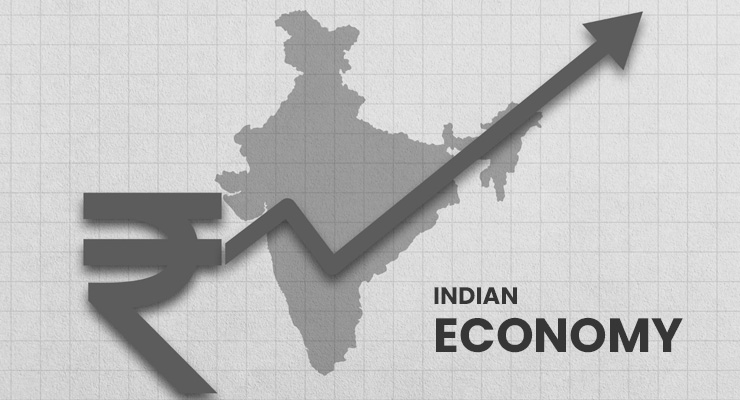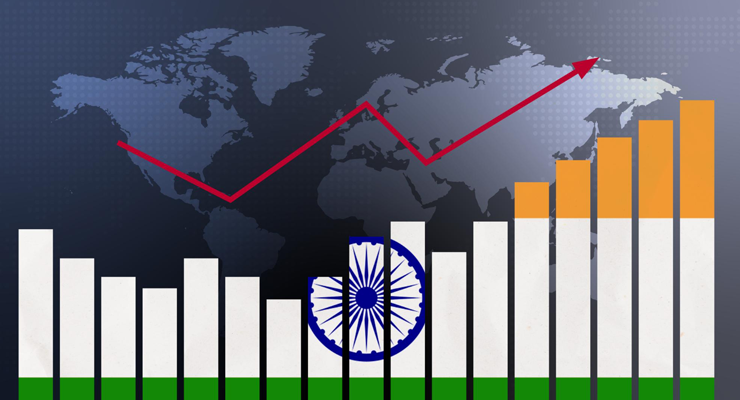Introduction
Welcome readers to my blog on exploring whether India Achieve Target of a $5 Trillion Economy. Let’s dive into the current state of the Indian economy, the $5 trillion target, and the obstacles in achieving it. India, currently the seventh largest economy globally, has been experiencing consistent GDP growth over the past few years. However, the COVID-19 pandemic has impacted it significantly. The Indian economy contracted by 7.7% in the financial year 2020-21 due to the pandemic’s impact on various sectors like manufacturing, tourism, and hospitality. The government’s decision to impose a nationwide lockdown led to a significant decline in demand and caused supply-chain disruptions.
The $5 trillion target set by PM Modi for the Indian economy by 2024-25 is ambitious but achievable. It requires an annual GDP growth rate of 8%, which means doubling the economy’s size in the next five years. The target’s idea is to transform India into a middle-income country, reducing poverty, and increasing per capita income. Obstacles in achieving the $5 trillion target are aplenty.
The Indian economy majorly relies on the agricultural sector, which contributes around 14% of the GDP. Poor infrastructure is another significant challenge. India’s roads, railways, airports and ports are inadequate and inefficient, making it challenging to do business. Lack of skilled labour and slow technological innovation are other factors that need consideration. In conclusion, India has a long way to go to achieve the $5 trillion economy target.
However, several policy initiatives taken by the government and an optimistic outlook are signs of hope. With the right measures and focus, coupled with a skilled workforce, a business-friendly environment, and the right technological advancements, India can indeed turn into the economic powerhouse that it aspires to be.
Indian Economy: A Snapshot

India, one of the fastest-growing economies in the world, has seen a steady GDP growth rate over the past decade. With a current GDP of $3 trillion, the country has set a target to achieve a $5 trillion economy by 2024. When it comes to the sector-wise contribution to the Indian economy, the service sector has been the biggest contributor while agriculture and manufacturing sectors have seen stagnation. However, the manufacturing sector has seen a spur in growth in recent years, making India an attractive destination for investment and fostering job creation.
Factors driving the growth of the Indian economy are a young and growing workforce, a burgeoning middle class leading to increased consumption, and a growing startup ecosystem promoting innovation. It is evident that India’s growth story so far has been impressive, but the question remains, can India achieve the $5 trillion target by 2024? Let’s explore the obstacles that stand in the way.
The $5 Trillion Target
Imagine walking into a store and seeing a gorgeous pair of shoes on the shelf. You’re hesitant to buy them because they might break the bank, but you just can’t resist. You know they’re worth the investment because they’re versatile, high-quality, and go with almost everything. Well, that’s what the $5 trillion target for the Indian economy is all about – a smart investment for long-term growth and stability. So, what exactly does this target mean? In a nutshell, it’s the amount of money India aims to generate in terms of Gross Domestic Product (GDP) by 2025. The current GDP is around $2.9 trillion, which means we need to grow at an average rate of 8% per annum (compounded annually) to achieve the target. Sounds intimidating, right? However, the government is not taking this target lightly. Various initiatives have been launched to accelerate economic growth and development.
The “Make in India” campaign, for instance, aims to increase local manufacturing and boost employment opportunities. The “Digital India” initiative focuses on improving connectivity and building a digitally empowered society. The recent budget also includes proposals such as the National Infrastructure Pipeline and the Vehicle Scrappage Policy, which are expected to give a much-needed boost to the economy. Apart from these initiatives, the government is also implementing economic policies that are geared towards achieving the target. These include measures to ease the banking and financial sector, relax foreign investment rules, and promote entrepreneurship.
The government also plans to increase public investment in infrastructure, education, and health sectors. However, achieving the $5 trillion target is not without its fair share of obstacles. For instance, the current state of infrastructure in India is a major concern. Poor roads, inadequate power supply, and archaic ports are just some of the hurdles that need to be overcome.
The labor force also poses a challenge, with a skills gap and complex labor laws making it difficult for businesses to thrive. Moreover, the manufacturing sector is facing a slowdown, and reforms in this area are much needed. To measure the progress towards achieving this target, various metrics can be used. GDP growth rates can give an overall idea of the country’s economic performance. Sector-wise analysis can be used to identify areas of growth and areas that require improvement.
Employment impact can also be used as a metric to determine the success of economic policies. In conclusion, achieving the $5 trillion target may seem like a Herculean task, but with the government’s efforts and pro-active measures, it is definitely achievable. With the right policies and initiatives, India can position itself as a global superpower and boost the standard of living for its citizens. Let’s hope, we can feature alongside the Googles and Apples of this world and garner the same sort of admiration for our economic powerhouses.
Obstacles in Achieving the Target

India’s goal of becoming a $5 trillion economy by 2025 is a tough nut to crack. The country has made considerable progress but there are still some major obstacles to overcome. The three main challenges that India has to tackle are infrastructure, labor force and the current state of manufacturing. Infrastructure Shortcomings: One major problem that India has to deal with is infrastructure shortcomings.
Lack of proper infrastructure not only increases the cost of doing business but also acts as a major hurdle in attracting investment. India still lags behind other developed economies in terms of quality infrastructure. Roads, rails, ports, airports, and power supply are some of the key areas that need urgent attention. India must adopt a holistic approach to infrastructure development and involve both private and public sectors to attract investment.
Labour Force Challenges: The second biggest problem is the labor force. The country’s current labor force is characterized by a high degree of informal workers, low skills, and low wages. India has to focus on providing technical education and on-the-job training to its labor force. It is important to recognize that attracting high-quality workers is necessary for the growth of the economy. Improving working conditions, safety and increasing the minimum wage is crucial for increasing workers’ productivity.
Current state of manufacturing in India: In addition, India’s manufacturing sector has a long way to go. The country’s manufacturing sector accounts for only 15-16% of GDP. While focusing on the services sector, India has underinvested in manufacturing. The sector needs more investment, R&D, and innovation to promote the Make in India initiative. The country needs to adopt advanced technologies and set up manufacturing hubs in different parts of the country. To achieve the $5 trillion mark, manufacturing must contribute to 25% of GDP.
Conclusively, India still has some way to go before it can achieve its $5 trillion economy goal. A combination of infrastructure, labor force and manufacturing reforms need to be implemented quickly. The government has to undertake these challenges urgently and work closely with the private sector for investment. The potential of India’s economy is immense, and if it can overcome these hurdles, then it can undoubtedly achieve its $5 trillion dreams.
Metrics for Measuring Performance

As India aims to become a $5 trillion economy, measuring its progress is critical. GDP growth rates and targets, sector-wise analysis, and impact on employment are key metrics to assess its performance. In terms of GDP growth rates, India’s goal is to achieve an average growth rate of 8%. However, in recent years, it has fallen short of this target. In 2019-2020, the GDP growth rate was 4.2%, which was the weakest in 11 years.
The pandemic had a severe impact on the economy, resulting in a contraction of 7.7% in 2020-21. For India to achieve its target of a $5 trillion economy, it needs to consistently achieve a growth rate of 8% or more. Sector-wise analysis is also crucial in measuring India’s performance. The services sector is the largest contributor to India’s GDP, followed by industry and agriculture.
Within the services sector, trade, hotel, transport, communication and broadcasting, and financing, insurance, real estate, and business services are the top contributors. In contrast, within the industry sector, manufacturing, construction, and utilities are the major contributors. Agriculture and allied activities, meanwhile, have been showing fluctuating growth patterns. Finally, the impact on employment is a metric that cannot be ignored.
A growing economy should result in job creation. However, India has been struggling with high unemployment rates in recent years. In 2019-20, the unemployment rate was 6.1%. In 2020-21, the rate further rose to 11.9%, primarily due to job losses caused by the pandemic.
Addressing the issue of job creation must remain a priority to achieve the goal of a $5 trillion economy. In conclusion, measuring India’s progress towards being a $5 trillion economy requires monitoring GDP growth rates, sector-wise analysis, and the impact on employment. While the journey won’t be easy, with the right policies, India can achieve its ambitious goal.
Role of Technology in Achieving the Target

When it comes to achieving the $5 trillion economy target, technology will no doubt play a significant role. The Digital India initiative launched by the government in 2015 serves as a crucial step towards this goal. Under this, initiatives like the BharatNet project, which aims to provide broadband connectivity to every village, and the DigiLocker, an online document storage platform, are being implemented to promote a digital ecosystem in the country.
Moreover, innovation and technology advancements in areas like AI, IoT, and blockchain can boost productivity, create job opportunities, and drive growth in different sectors. With the government’s focus on promoting startups and entrepreneurship, India is poised to become a hub of innovation. However, bridging the digital divide and ensuring that technology benefits all sections of society is crucial.
Given that a significant percentage of the population still lacks access to the internet, efforts must be made to make technology affordable and accessible to all. In conclusion, technology can serve as an enabler in achieving the $5 trillion economy target. With the right policies, investments and initiatives, India can leverage technology to create a more inclusive and sustainable economy.
Conclusion
India, with its rich history, diverse culture, and rapidly growing economy, has set ambitious goals to reach a $5 trillion economy. This article delves into the various strengths that can catapult India’s economy, along with key focus areas, and highlights the potential of its massive population as a driver of growth.
- Harnessing the Power of a Massive Population: One of India’s greatest assets is its massive population, which currently stands at over 1.3 billion people. This vast consumer base presents a tremendous opportunity for businesses, both domestic and foreign, to tap into a growing market. By effectively targeting this population, companies can expand their customer base and drive economic growth. Additionally, this large workforce can be leveraged to address skill gaps, fuel innovation, and boost productivity, leading to enhanced economic output.
- Robust Domestic Demand: India’s domestic consumption has been a driving force behind its economic growth. With a rising middle class and increasing disposable income, the demand for goods and services is steadily growing. This trend offers significant opportunities for businesses, particularly in sectors such as retail, e-commerce, and consumer durables. By catering to the needs and aspirations of the domestic market, India can fuel economic expansion and attract further investments.
- Innovation and Technology: India has emerged as a global leader in information technology and software services. The country’s tech-savvy workforce, coupled with a robust startup ecosystem, fosters innovation and technological advancements. Emphasizing research and development (R&D) initiatives, promoting entrepreneurship, and encouraging investments in cutting-edge technologies like artificial intelligence, blockchain, and clean energy can provide a competitive edge to Indian businesses and drive economic growth.
- Focus on Infrastructure Development: Investing in infrastructure development is crucial to supporting economic growth. India has recognized this need and launched several initiatives such as the “Smart Cities Mission” and the “Bharatmala Project” to improve transportation, urban planning, and connectivity. Strengthening infrastructure across sectors like transportation, logistics, energy, and telecommunications will not only facilitate smoother business operations but also attract investments, create jobs, and drive overall economic development.
India’s journey towards becoming a $5 trillion economy hinges on leveraging its inherent strengths and addressing key focus areas. By harnessing the power of its massive population, tapping into domestic demand, promoting innovation and technology, and investing in infrastructure, India can unlock its true economic potential. With strategic policies, supportive government initiatives, and collaborations with international partners, India is well-positioned to achieve its ambitious economic goals and emerge as a global economic powerhouse.
Disclaimer: The views expressed in this blog are for educational purposes only. This is not professional advice. Consult your financial advisor before investing.




